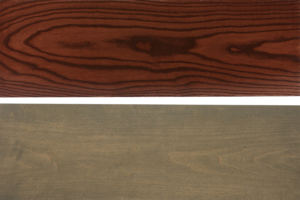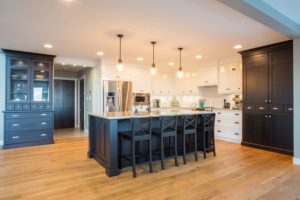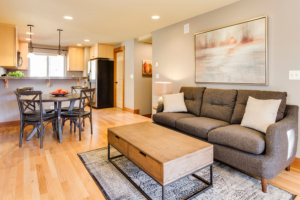Mix Wood Tones Like an Expert Interior Designer
Thinking about mixing wood tones in your home but concerned that you’ll end up with a busy, miss-matchy look? Let us put your mind at ease!
Mixing tones of wood furniture and wood floors can create visual interest, leaving you with a stunning, professional-like home design. All you have to do is put a little thought into how the different wood tones interact with one another. Let’s take a look at the considerations you need to take into account before getting started.
Types of Wood Tones
When you decide to start mixing wood tones, it’s important to understand the language used in interior design. This will give you a sense of what elements are most important when you match wood tones.
Dominant Wood Tone
The dominant tone refers to the tone of the wood that takes up the most visual space in the room, whether it’s the largest piece of wood furniture or the wood flooring. The dominant wood tone is typically going to be the statement piece that you select all the other wood furniture based off of.
Undertones
Undertone is the underlying hue of the wood elements. Undertones come in three categories: cool, warm, and neutral. A great way to match wood tones is to mix pieces of wood furniture that have darker or lighter shades of the same undertone.
Cool Tones
Cool tones for hardwoods are a little more difficult to come by with natural wood, that’s why wood stain plays an important role. Typically cool tones include a range of gray, black or blue. Wood species that can have cool undertones are ash, maple, poplar and pine.
Warm Tones
Warm undertones have a hint of red, yellow, orange or pink. Popular warm wood options include cherry, hickory, and mahogany. Warm wood tones are one of the most popular home decor trends, creating an earthy, homey feeling.
Neutral Tones
Neutral tones have a beige look to them. White oak has a very neutral undertone, making it an easy wood to stain (which, in turn, allows it to fall into the other undertone categories). Other wood species with neutral undertones include hazelnut and walnut.

Mixing Wood Tones for Elevated Interior Design
There are a number of ways you can mix wood tones when it comes to home decor. From living room to dining room, these tips can help you create a cohesive, stylish look for your interior design style.
Matching Wood Undertones to the Dominant Tone
The best way to mix wood tones while avoiding the look of miss-matchy home decor is to keep an eye on the undertones. Look at the largest piece of wood furniture, such as the dining table or coffee table (or hardwood floors if you have them), and determine if it’s a warm wood tone, cool wood tone or neutral wood tone. Keeping the space’s wood pieces in the same undertone family will create a natural feel to your space, whether you’re decorating your entryway or your living room.

Add Contrasting Wood Tones That Have the Same Undertone
While staying within the same undertone category is a MUST, that doesn’t mean you can’t mix dark and light wood species!
Contrasting wood colors can create a point of visual interest. Why not make a bold statement by placing high contrast pieces together in a room? The era of matching all wood species in a space is over!
If you’re afraid to go all-in, choose a small statement piece of furniture, such as a picture frame or side table. High contrast can help make a room feel dynamic (or even dramatic), and create visual interest. We promise, contrasting wood tones are your friend!
If you’re still a little fearful, you can lessen the contrast by breaking it up. Put down a rug to give some space between a piece of dark furniture and light wood flooring, allowing the contrasting wood tones to come together more seamlessly.

Mixing Metals With Lighter Wood
Another way to develop contrast is to add metal elements into the mix. The combination of dark and light can help break up the visual space of a room and draw attention to specific pieces of furniture. For instance, having a lighter wood floor and cabinetry with dark metal accents will help draw eyes to a variety of elements. A lighter wood floor broken up with darker tones also makes a space feel larger.
Use Similar Grain Patterns
A great way to create a sense of cohesion is to pay attention to the wood grain. Smaller, less noticeable grain patterns will match more easily, and can fall within a variety of design styles (modern, contemporary, mid-century modern and coastal). A more prominent wood grain makes the room feel more rustic – and often, it’s best to try and match the grain pattern across different wood tones to bring your space and wood furniture together.
Keep in mind, though, that too much of a good thing can be overwhelming. While dark wood floors and furniture can create a sense of intimacy and closeness, too much of it in one room might make the space feel claustrophobic. Break it up with medium-to-lighter wood furniture with a similar grain to help the space breathe.
Mix It Up With Baird Brothers
If you’re looking for resources when it comes to hardwood DIY projects and home decor, Baird Brothers Fine Hardwoods has what you need to mix wood tones like an interior designer. We offer an endless selection of quality hardwoods – lumber, flooring, casing, baseboard, crown moulding, interior doors and more. Warm or cool, dark or light, we have the hardwood elements that make your space feel just right. Shop our inventory online or contact us today about your upcoming home decor or renovation project.



